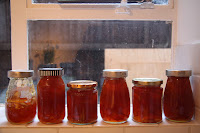The one draw-back to their blooming vision is that no-one seems to think it is possible to produce flowering sweet peas in May. This is a challenge I have embraced, with uncertain expectations as to my chances of success. My determination has only been strenthened by Paul's account of Christmas lunch, at which three of his grannies were united (possibly for the first time) in agreement that I was unfortunately yet undoubtedly doomed to failure. Will I be able to confound the combined consenus of these three matriarchs?
 I sowed the seeds in January: 4 varieties (Incense Mixed, Cuthbertson Mixed, Galaxy Mixed and Old Spice Mixed) (with hindsight it might have been better to have limited myself to the early flowering Cuthbertson and Galaxy varieties...), totalling 150 seeds in 30 pots. They germinated in 3 weeks (despite the doom-mongers and grannies predictions that they would never germinate in the January cold). They are now growing strong in my greenhouse. So far so good.
I sowed the seeds in January: 4 varieties (Incense Mixed, Cuthbertson Mixed, Galaxy Mixed and Old Spice Mixed) (with hindsight it might have been better to have limited myself to the early flowering Cuthbertson and Galaxy varieties...), totalling 150 seeds in 30 pots. They germinated in 3 weeks (despite the doom-mongers and grannies predictions that they would never germinate in the January cold). They are now growing strong in my greenhouse. So far so good. In due course I will plant them out into pots in which they will stay until the wedding (sweet peas hate having their long roots disturbed). I will feed them liquid tomato food, move them between the sunniests spots in the garden, whisper sweet pea nothings in their sweet pea shaped ears and generally encourage, cajole, beg and entreat them to flower, abundantly, by 21 May 2011.
In due course I will plant them out into pots in which they will stay until the wedding (sweet peas hate having their long roots disturbed). I will feed them liquid tomato food, move them between the sunniests spots in the garden, whisper sweet pea nothings in their sweet pea shaped ears and generally encourage, cajole, beg and entreat them to flower, abundantly, by 21 May 2011. Once upon a time there was a small balcony in Battersea, where I lived with Paul and Ellie. The balcony bore the beginnings of my gardening entreprise. In the early days the balcony was home to pots of herbs. These pots were welcomed by Paul and Ellie, as they provided irrefutably valuable additions to our cooking, Pimms, mohitos and even the odd pot of mint tea. (They also saved us from needing to purchase packets of herbs from the supermarket at gross expense, thereby appealing to Ellie's accountant's sense of prudent financial management). As my ambitions grew I expanded the balcony's offerings, though alas not the balcony itself, with the addition of three tomato plants. As the plants grew (most vigorously and successfully), the available space to sit and enjoy a drink or dinner alfresco diminished and I increasingly came home to find Paul and Ellie cowering under the Jack and the Beanstalk of the tomato world, albeit supping on a delicious tomato salad. When I moved, not surprisingly, the plants came with me.
With any luck the sweet peas will flower by 21 May and Paul and Ellie will retrospectively consider the early honing of my horticultural skills to have been worth while...
This week's recipe is (one of) Paul's signature cocktails, much sampled on the balcony in Battersea.
Moonwalkers
(Moonwalkers were invented for Neil Armstrong, by Joe Gilmore who was the head barman at the Savoy. It is legend in Paul's family that Paul's great uncle practically took up residence in the bar at the Savoy and this cocktail has been a family favourite ever since.)
Fresh grapefruit juice
Grand Marnier
Champagne/Cava/Prosecco
Rose water (if you are being faithful to Joe Gilmore's original recipe)
Mix two parts grapefruit juice to one part Grand Marnier in a jug. Add a dash of rosewater, if desired (too much will ruin it so add with caution). Pour the mix into champagne flutes, so it fills about one third of the flute. Top up with Champagne/Cava/Prosecco.
Health warning: Moonwalkers taste like juice but more than a few glasses and you will not be safe on the balcony...











